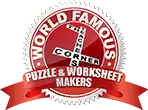 The Teacher's Corner
The Teacher's Corner
Understanding Television Science Experiment
Slim View
This week's experiment involves a simple challenge. You cut a narrow slit into a piece of cardboard and then read the writing on a sheet of paper through the slit. Easy, right? Oh, I forgot to tell you that you must lay the sheet of paper on a flat surface and then lay the cardboard directly on top of it. It may not seem so easy now, but as you will see, it is still a simple task.
To try this, you will need:
- a piece of cardboard or thick paper
- scissors
- a sheet of newspaper or some other flat sheet of paper with writing on it
First, we need to cut a long, narrow slit in the center of the piece off cardboard. I used a paper plate and found it worked very well. Of course, I had to eat the cookies that were on the plate, but we must all make sacrifices.
I folded the plate in half and then used the scissors to cut a thin strip along the center of the fold. When I unfolded the plate, I had an opening about 1/4 of an inch wide and 5 inches long. That worked very well for me.
Once that is done, lay the sheet of paper with the writing on a flat surface. Place the cardboard on top of it. Now, read the writing through the slit. Not very easy. If you move the cardboard around, you can probably manage to read a few words at a time. As you move the cardboard to different positions, you can see different words through the slit.
But what if you wanted to see more than a few words at one time? Of if you wanted to look at a photograph? To try that, have someone put a sheet of newspaper with a photo under the cardboard while you are not looking. Then try to figure out what the photo is, by looking through the hole in the cardboard. Not very easy.
To make it easier, slide the cardboard back and forth very quickly over the paper. As you move it back and forth, you should be able to see the entire photo, all at the same time. Well, actually, you are still only seeing it a tiny bit at a time, but the different bits show up so quickly that you see them as a single picture. Try sliding the cardboard back and forth over the writing and you will find that you can easily read it.
This is the principle behind how your television screen works. In several past experiments we have talked about the dots on your TV screen. If you have never looked at them before, take a minute and do it now. Get up very close to the screen and you will see that the picture is made up a many small dots. The amazing thing is that only one dot at a time lights up. That is right. Only one dot at a time. The first dot lights up, and then the second, and so on, making lines across your screen. This happens so fast that your eye and brain combine them together into the picture, just as it combined the different bits seen through the slit in the cardboard.
Now, try something different. Place the cardboard onto your TV screen. Slide it back and forth as you did on the paper. Do you see the entire picture? No. Instead, you see several slices of the picture. Moving the slit back and forth lets you see the times when the screen is dark. The screen flickers so fast that you normally can't see it, but now you can.
I don't recommend doing this experiment with an LCD screen, such as you have on a laptop. They do not flicker like a TV screen and they are easily scratched or damaged.
 Check out more Exciting Experiments
Check out more Exciting Experiments
All lessons are brought to you by The Teacher's Corner and Robert Krampf's Science Education Company.
Robert Krampf's Science Shows thehappyscientist.com